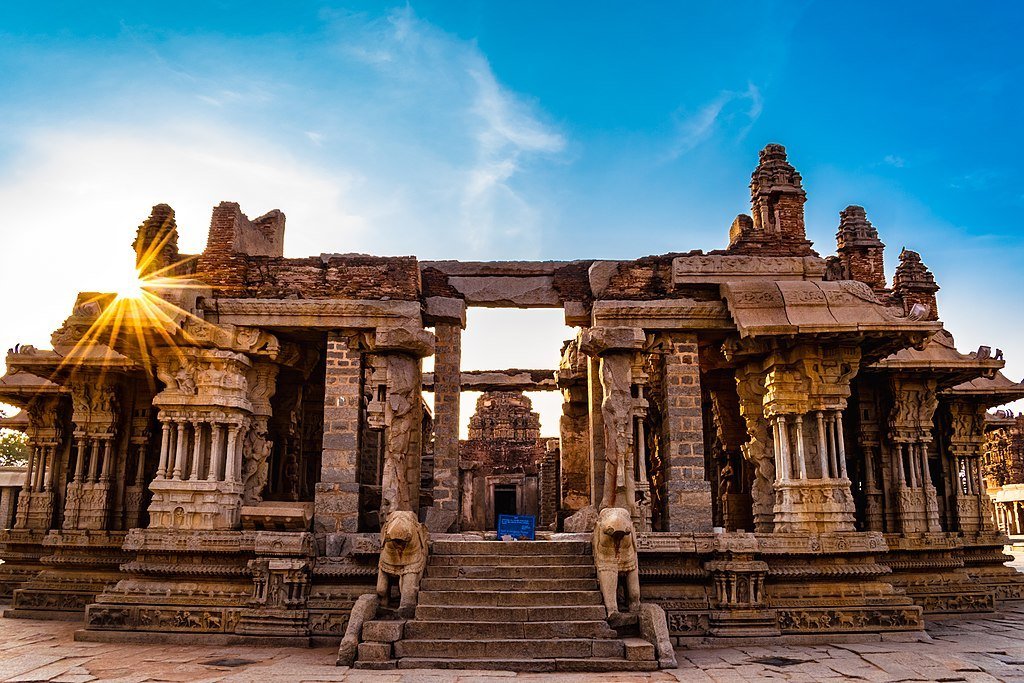Hampi Sri Vitthala Temple, Karnataka

Address
Hampi Sri Vitthala Temple, Hampi Bellary Hospet, Karnataka-583239
Diety
Vishnu
Introduction
Hampi or Hampe, also referred to as the Group of Monuments at Hampi, is a UNESCO World Heritage Site located in east-central Karnataka, India. It is a pilgrimage centre of the Hindu religion. Hampi was the capital of the Vijayanagara Empire in the 14th century. Chronicles left by Persian and European travellers, particularly the Portuguese, say that Hampi was a prosperous, wealthy and grand city near the Tungabhadra River, with numerous temples, farms and trading markets. By 1500 CE, Hampi-Vijayanagara was the world’s second-largest medieval-era city after Beijing, and probably India’s richest at that time, attracting traders from Persia and Portugal. The Vijayanagara Empire was defeated by a coalition of Muslim sultanates; its capital was conquered, pillaged and destroyed by sultanate armies in 1565, after which Hampi remained in ruins. Located in Karnataka near the modern-era city of Hosapete, Hampi’s ruins are spread over 4,100 hectares (16 sq mi) and it has been described by UNESCO as an “austere, grandiose site” of more than 1,600 surviving remains of the last great Hindu kingdom in South India that includes “forts, riverside features, royal and sacred complexes, temples, shrines, pillared halls, mandapas, memorial structures, water structures and others”. Hampi predates the Vijayanagara Empire; there is evidence of Ashokan epigraphy, and it is mentioned in the Ramayana and the Puranas of Hinduism as Pampaa Devi TirthaKshetra.Hampi continues to be an important religious centre, housing the Virupaksha Temple, an active AdiShankara-linked monastery and various monuments belonging to the old city.
Puranic Significance
The Vitthala temple and market complex is over 3 kilometres (1.9 mi) north-east of the Virupaksha temple near the banks of the Tungabhadra River. It is the most artistically sophisticated Hindu temple in Hampi, and is part of the sacred centre of Vijayanagara. It is unclear when the temple complex was built, and who built it; most scholars date it to a period of construction in the early-to-mid-16th century. Some of the books mention that its construction began during the time of Devaraya II and continued during the reign of Krishnadevaraya, Achuytaraya, and probably Sadasivaraya and it stopped probably due to the destruction of the city in 1565.The inscriptions include male and female names, suggesting that the complex was built by multiple sponsors. The temple was dedicated to Vitthala, a form of Krishna also called Vithoba.The temple opens to the east, has a square plan and features an entrance gopuram with two side gopurams. The main temple stands in the middle of a paved courtyard and several subsidiary shrines, all aligned to the east. The temple is a unified structure in a courtyard measuring 500 by 300 feet which is surrounded by a triple row of pillars. It is a low structure of one storey with an average height of 25 height. The temple has three distinct compartments: a garbhagriha, an ardhamandapa and a mahamandapa (or sabhamandapa). The Vitthala temple has a Garuda shrine in the form of a stone chariot in the courtyard; it is an often-pictured symbol of Hampi. Above the chariot is a tower, which was removed during 1940s, as per historian Dr.S.Shettar. In the front of the stone chariot is a large, square, open-pillared, axial sabhamandapa, or community hall.The mandapa has four sections, two of which are aligned with the temple sanctum. The mandapa has 56 carved stone beams of different diameters, shape, length and surface finish that produces musical sounds when struck; according to local traditional belief, this hall was used for public celebrations of music and dancing.It is classified as Karakkoil, a temple fashioned after temple chariots which are taken in procession around the temple during festivals. The mandapa links to an enclosed pradakshinapatha for walking around the sanctum. Around this axial mandapa are (clockwise from east); the Garuda shrine, the Kalyanamandapa (wedding ceremonies), the 100-columned mandapa, the Amman shrine and the Utsavmandapa (festival hall). Outside the temple compound, to its east-south-east, is a colonnaded market street almost one kilometre (0.62 mi) long; all of which is now in ruins. To the north is another market and a south-facing shrine with reliefs of Ramayana scenes, Mahabharata scenes and of Vaishnava saints. The north street ended in a temple honouring the Hindu philosopher Ramanuja. The region around the Vitthala temple was called Vitthalapura. It hosted a Vaishnava matha designed as a pilgrimage centre . It was also a centre for craft production according to inscriptions found
Century/Period/Age
17th century
Managed By
UNESCO World Heritage Centre
Nearest Bus Station
Badami, Aihole
Nearest Railway Station
Hosapete
Nearest Airport
Jindal






